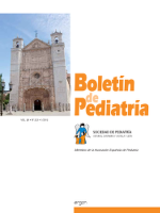Gestación sin controlar y su impacto socio-sanitario en una población pediátrica
L. Calle Miguel , R. Pardo de la Vega , G. Solís Sánchez , E. Lombraña Álvarez , C. Pérez Méndez , M.T. González Martínez
Bol. Pediatr. 2013; 53 (223): 28 - 36
Introducción El seguimiento prenatal ha logrado un aumento importante de la supervivencia neonatal. El mal control del embarazo está en relación con el nivel socioeconómico y otros factores sociales complejos. Pacientes y métodos Estudio observacional, retrospectivo y descriptivo de los recién nacidos de gestaciones no controladas en el Hospital de Cabueñes (Gijón, Asturias) entre 2006 y 2010, seguido de un análisis comparativo con una población control. Resultados Se registraron 92 gestaciones no controladas (8,31 casos/1000 recién nacidos). El 45,7% de las madres eran españolas y un 14,1% declararon consumir sustancias de abuso. La edad gestacional media fue de 37,7 semanas. Un 20,7% de los niños fueron cedidos para adopción y se procedió a la retirada definitiva de la custodia en el 10,9% de los casos. Se detectaron dos serologías postnatales positivas para el Virus de la Inmunodeficiencia Humana y tres para la Hepatitis C. Respecto al grupo control, las madres que no controlaron el embarazo fueron significativamente más jóvenes (26,9 vs 32,1 años) y tenían más hijos previos (1,73 vs 0,5) e interrupciones voluntarias del embarazo (0,34 vs 0,02). Sus hijos presentaron mayor porcentaje de prematuridad (25% vs 5,4%) y de ingresos en Cuidados Intensivos Neonatales (6,6% vs 2,2%) y peor adherencia a las Consultas Externas (53,4% vs 95,5%). Conclusiones El mal control del embarazo supone un problema relativamente frecuente en nuestro medio. Las madres se ajustan mayoritariamente a un perfil social característico. Estos niños presentan mayor prematuridad y morbilidad en el periodo neonatal y peor seguimiento hospitalario posterior.
Pregnancy without control and its social-health care impact in a pediatric population
Background.
Routine antenatal care has increased neonatal surviving rates. Non-attending for antenatal care visits is related to several complex social and economical factors.
Patients and methods.
An observational, retrospective, descriptive review of all the infants born in Hospital de Cabuenes (Gijon, Asturias) following pregnancies with inadequate antenatal care between 2006 and 2010 and comparison with a control group.
Results.
Ninety-two pregnancies (8.31 cases/1000 liveborn infants) did not attend any antenatal care visits. Fortyfive percent of the mothers were Spanish and 14.1% reported drug abuse during pregnancy. Average gestational age was 37.7 weeks. Twenty-one percent of the newborns were given up for adoption, and the child's custody was removed from the parents in 10.9% of cases. Two cases of Human Immunodeficiency Virus infection and three cases of hepatitis C virus infection were found in postnatal serology studies. Compared to the control group, mothers without antenatal pregnancy care were significantly younger (26.9 vs 32.1 years old) and were more likely to have more previous children (1.73 vs 0.5) and previous voluntary pregnancy interruptions (0.34 vs 0.02). Prematurity rates (25% vs 5.4%) and admission to the Neonatal Intensive Care Unit (6.6% vs 2.2%) were more frequent in these children, as well as a worse adherence to low-up in the Outpatient Clinic (53.4% vs 95.5%).
Conclusions.
Lack of antenatal care is a relatively common problem in our area. Mothers generally share a characteristic social profile and their infants show higher prematurity and morbidity rates in the newborn period and are less likely to attend follow-up visits.
Artículo completo (PDF) (102 kb.)
- Otros
